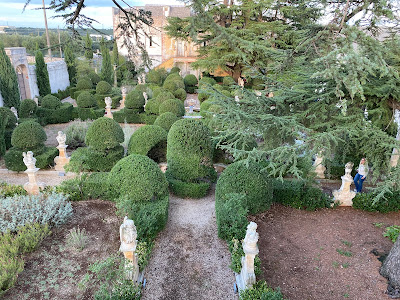Locorotondo, Puglia, Italy. Monday 29-August-2022.
A wonderful tour of a historic garden practically on our doorstep. The only Italianate garden south of Rome with a fascinating history. Ancient cedars, a collection of bonsai and formal gardens with statues of the months and seasons. Finishing up with a tasting of local wines.
We knew nothing of the existence of this amazing place but for the fact that our friends spotted a listing for a Passeggiata nel Giardino Storico con...calice di vino. We were met by our host Annalisa and the guided tour was given by Mimo. It was good practice for my Italian listening skills and fortunately Mimo spoke clearly and not too fast so I could follow most of what he said.
The gardens owe their existence to the fact that the one of the owners, Francesco Caramia, actually lived on the farm estate rather than in a palazzo in town like most landowners. This prompted him to beautify his estate, expanding the buildings and constructing the garden.
The garden has a rectangular plan with the sides having a ratio of 2:1, divided into eight flower beds sections with a gate on each side and fountain in the middle.
Stairs and balcony at the back of the Masseria overlooking the garden.
View from the balcony.
The garden had twelve statues for each of the months of the year and four for each of the seasons.
There are no rivers in Puglia and water is a challenge; formal gardens require a lot of watering. Here Mimo was explaining part of the irrigation system: water from the roof was channeled across an archway and into a cisterna (water tank), one of many in the garden.
The forecourt between the Masseria and the Garden also had a sophisticated irrigation system that flowed twice round the flower beds and then out through channels under the paths.
The water is then fed to a large well under the central fountain.
Out through a side gate we visited the bonsai collection, not original to the garden but providing a home for the Valle d’Itria Bonsai Cultural Association.
One of my favourite bonsai.
And another.
At the opposite end of the garden is a hexagonal tea room and belvedere from which the owners could admire their garden or turn round and survey their lands.
View from the belvedere showing a number of the statues.
A panorama of the garden including one to the two ancient cedars.
The front of the Masseria. It looked familiar because we came to a concert here back in 2015 as part of the Locus Festival: George Clinton and Parliament Funkadelic.
I was skeptical that the tour would take the two hours advertised but there was so much to learn. Finally the wine tasting from a local producer. The white was a blend of chardonnay and aglianico, the rose was negroamaro. Both very pleasant and quite low in alcohol - only 12.5 ABV, unlike a number of more potent wines from this far south.
The full history can be found on their FaceBook page:
The origins of the Ferragnano masseria date back to 1500, following the liquidation by the Court Regia of the territory of Selva Monopolitana, of which Locorotondo was part of. His appearance was very different from now on. We can imagine her surrounded by trulli and cummerse. Two centuries later, the masseria became the property of Vitantonio Montanaro, doctor of law, born in 1694 and elected governor of Martina Franca in 1728. Having no kids the Dr. Montanaro left the masseria to the third and last wife, Maria Maddalena Pinto, who in her second marriage had Francesco Caramia from Giuseppe Caramia of Martina Franca. Francesco Caramia renovated the residential complex of the masseria, building in 1811, under the direction of the locorotondose architect Giuseppe Campanella, the master "mess" with the present monumental staircase, the church of 1812 and the "pit garden Torresco”, at the bottom of which he built, in 1833, a Belvedere pavilion from which he can admire the surrounding countryside and the Bell tower of St George’s Church, covered with shiny blue and white bricks
In 1847 Francesco Caramia named his universal heir Giovanni Basile, son of Martino Basile and Carmela Calella, on a pact that little Giovanni would go and live with Carmela Giovine, wife of Francesco Caramian. Giovanni Basile Caramia continued like his predecessor to beautify the garden, engraving in the stone verses insulting to the beauty and the badness of life.
Upon his death, the Ferragnano masseria passed to Opera Pia Basile-Caramia, having been buried by his grandson Giovannino Basile, to whom he had inherited all his belongings. With the money from the work pia the agricultural school was built, to educate the children of the poor farmers in the Municipality of Locorotondo.
The garden of Masseria Ferragnano is a monumental Italian garden, rectangular plant, surrounded on one side by a high fence wall, with two side entrances. There are eight flower beds, perfectly symmetrical, surrounded by wood hedges, in the center of which there is a fountain. Along the avenues, the garden is adorned with benches, columns, a couple of wells and 34 baroque tombstone busts that symbolize the months of the year, the seasons, virtues and some nymphs and goddesses. The verses engraved on stones and marbles make the garden even more precious.
At the end of the garden, crowning a path reserved in the green, there is a terrace with balusters and towers, designed as a belvedere to spread over the surrounding countryside.
Since 1995 the Historical Garden and some premises on the ground floor of the masseria have been entrusted to the Valle d’Itria Bonsai Cultural Association which has made it their headquarters and provides continuous maintenance to make it fruitful for both exhibitions and little shows for celebrating weddings with rite civ.


























































